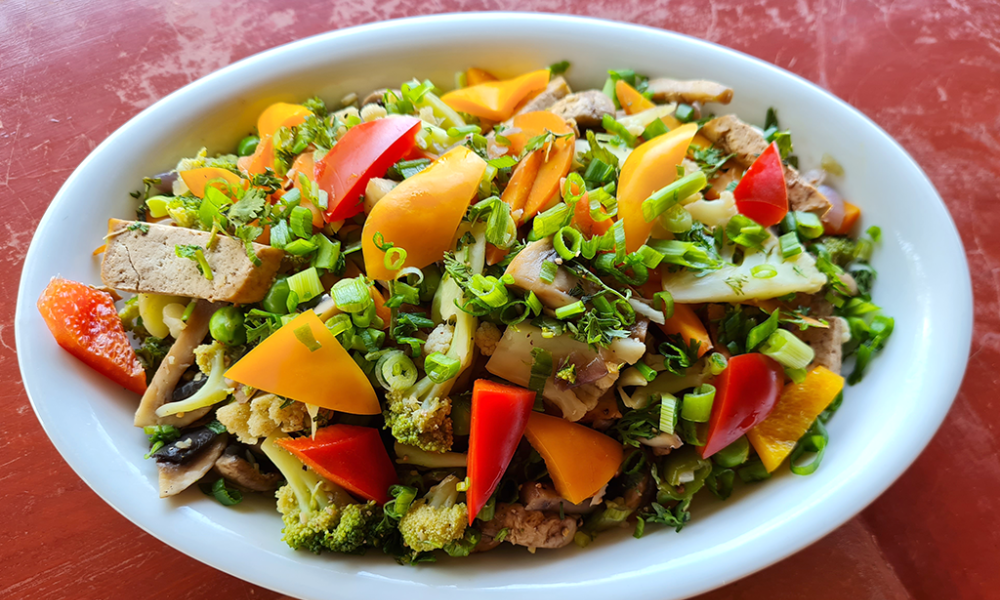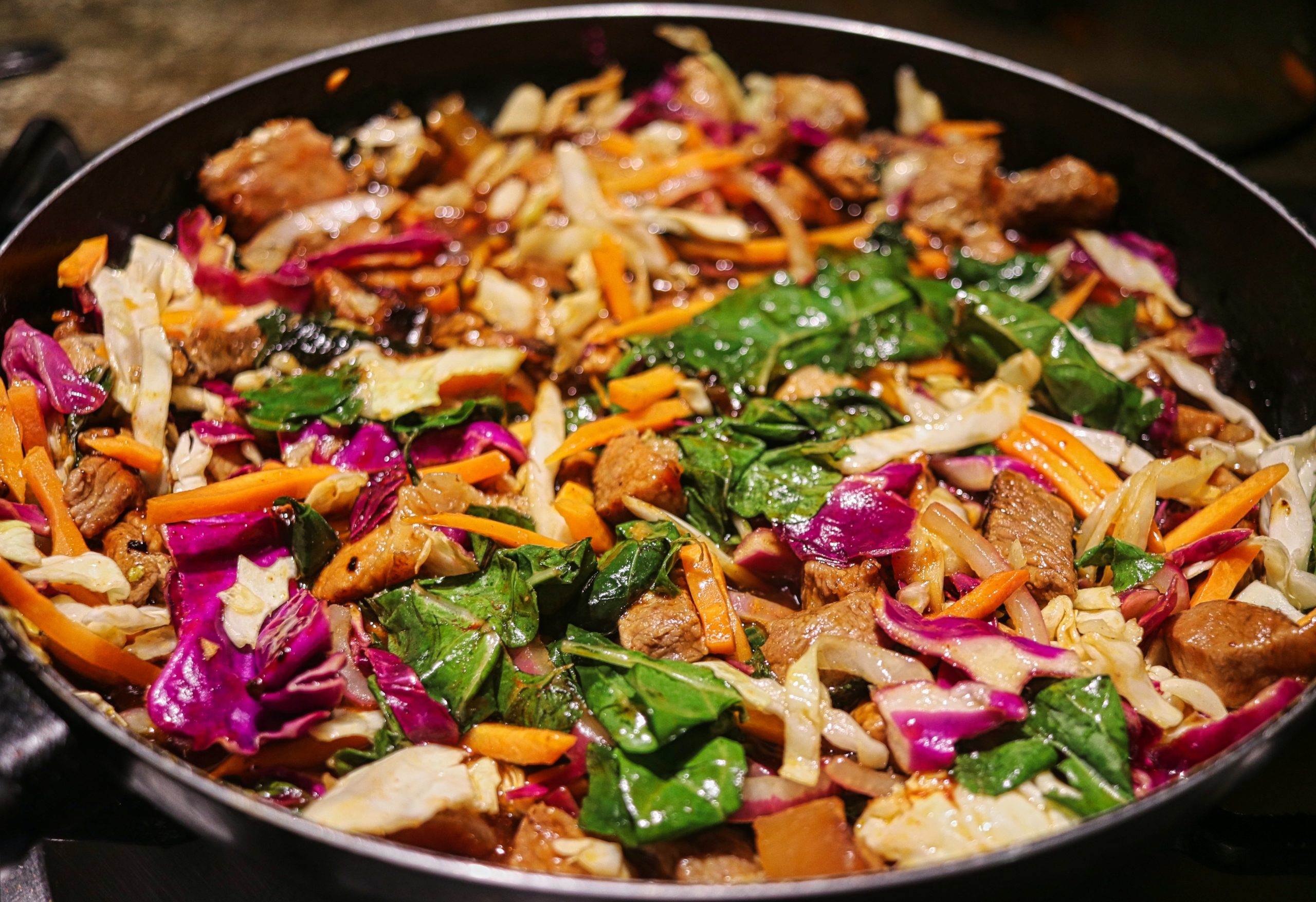Stir-frying veggies is a quick and easy way to cook them while keeping their nutrients intact. It’s a versatile cooking method that allows you to use a range of veggies while experimenting with different sauces and seasonings. This guide will walk you through the processes and techniques for cooking a tasty vegetable stir-fry.
Make sure your ingredients are prepared and ready to use before you begin cooking. This includes chopping up your vegetables and weighing out any sauces or seasonings you intend to use. Seasonings such as soy sauce, oyster sauce, fish sauce, and rice vinegar can be used to enhance the flavors of the veggies. It’s also vital to stir-fry in tiny batches to avoid crowding the pan and ensure equal cooking.
You can make a tasty and healthy vegetable stir-fry that is sure to please your taste buds with a little bit of forethought and some simple strategies.
How to Make Vegetable Stir Fry?
Making your stir fry healthy by including vegetables is a terrific idea. Try combining various vegetables. Your supper will become more interesting and delightful as a result of this. To your dish, you can also add Sauce. Here’s a quick recipe for vegetable stir-fry:
Ingredients:
- One tablespoon oil (vegetable or canola oil)
- One sliced onion, two garlic cloves, and minced
- 1 sliced red bell pepper
- 1 cup florets broccoli
- 1 cup mushrooms, sliced
- 1 cup carrots, sliced
- Two tablespoons of soy sauce
- One tablespoon of rice vinegar
- One teaspoon of cornflour (optional)
- Season with salt and pepper to taste.
Instructions:
- Heat the oil in a big pan or wok over high heat.
- Stir-fry the onion and garlic for 2-3 minutes or until softened.
- Stir in the bell pepper, broccoli, mushrooms, and carrots for another 3-5 minutes or until the veggies are cooked but still crisp.
- Combine the soy sauce, rice vinegar, cornflour, salt, and pepper in a small mixing basin.
- Stir the Sauce into the vegetables to coat.
- Cook for more than 2 minutes or until the Sauce is thick.
- Enjoy it with rice or noodles!
Additionally, you can substitute or add any additional vegetables to the dish to suit your preferences. To make it a complete meal, add a protein such as tofu, chicken, or shrimp.
What are the Essential Steps in Making an Excellent Stir-Fry?
A successful stir-fry requires several crucial steps:
- Preparing the ingredients: Chop all of the ingredients into bite-size pieces to ensure that they cook evenly and quickly.
- Before adding the oil, make sure your pan or wok is sufficiently heated. This will keep the ingredients from sticking and allow them to cook more rapidly.
- Stir-fry in tiny batches: To prevent overflowing the pan, sauté your vegetables or meat in small batches. This allows the items to cook more evenly and rapidly.
- Seasoning: To enhance the flavors of the ingredients, use a nice balance of seasonings like soy sauce, oyster sauce, fish sauce, and rice vinegar.
- Don’t overcook the vegetables: they should be slightly crunchy rather than mushy. Proteins such as chicken, beef, or shrimp should be well-cooked but not overcooked.
- Add the Sauce at the conclusion of the cooking process so that it thickens and coats the ingredients evenly.
- Serve hot: Stir-fry should be served hot to keep the ingredients crunchy and the flavors vibrant.
How to Mix and Match Vegetables?
There are a few suggestions you should keep in mind when preparing vegetable stir fry, whether it’s the main course or a side dish. Using some leftover vegetables is also a smart option because stir fry is a fantastic way to use up leftovers.
Additionally, cutting your vegetables into uniform pieces is a smart idea. This guarantees even cooking. Additionally, you might wish to season your veggie stir fry with additional spices. Garlic and ginger powder can be used to add flavor. Sesame oil and a little soy sauce are optional additions.
Tofu can be included in your stir-fried veggie dish. Protein may be easily added to your dish by using tofu. However, cooking can be a lengthy process. You can always add tofu to the top of your stir fry if you don’t have time for this stage. You may make your own stir-fry sauce this way and save time.
How to Produce Blanch While Preparing the Recipe?
Before producing a vegetable stir fry, performing a blanch is a crucial step to prevent flavor and color loss. When you defrost the vegetables, you also don’t want them to turn mushy.
Through this procedure, part of the vegetables’ bitterness will be reduced while the nutrients are maintained. Blanching your vegetables ahead of time will also help you save time later.
Vegetables can be quickly prepared by blanching, but it’s crucial to keep in mind that overcooking them will cause a loss of flavor and color. To prevent this, consider boiling smaller vegetables for a short period of time and larger vegetables for a short period of time.
You can prepare many batches of vegetables if you have the time. For instance, four to six tomatoes can be submerged for 30 to 60 seconds in boiling water. This will make it simple to remove the skin. A few tablespoons of kosher salt should also be added to the water. This is due to the salt’s ability to preserve the vegetables’ green hue.
How to Add Sauce?
A fantastic method to enhance the flavor of your dinner is by adding Sauce to vegetable stir-fries. Stir fry sauce goes well with practically any protein or veggie. This meal may be made quickly and easily. Even the Sauce can be prepared in advance. For up to three days, it can be kept in the fridge.
A wonderful approach to using up vegetables that aren’t quite ready to eat is to add Sauce to vegetable stir-fries. You can also prepare a stir-fried meal with frozen and canned vegetables. Even tofu or plant-based meat substitutes are acceptable in your Recipe.
Make sure you have all of the ingredients prepared before adding the Sauce to the stir-fried vegetables. When you attempt to accomplish too much at once, your dish’s texture will suffer. Additionally, make sure the Sauce is uniformly distributed over the ingredients.
How to Serve Stir-Fried Vegetables?
A vegetable stir-fry can be served in a variety of ways:
- Over rice: Steamed white or brown rice is a traditional way to serve stir-fry. The rice absorbs the flavors of the Sauce and provides for a complete and delicious supper.
- Over noodles: Over noodles is another common way to serve stir-fry. You can use any noodles you choose, including lo mein, udon, and soba.
- Stir-fry can be served with quinoa or couscous instead of rice or noodles for a healthier and lighter option.
- Serve the stir-fry inside a warm tortilla or lettuce wrap for a quick and easy meal.
- Serve as a side dish: You may serve the stir-fry as is or add a protein like tofu, chicken, or shrimp to make it a complete meal.
- As a salad: For a refreshing and healthful supper, combine the stir-fry with mixed greens and a vinaigrette dressing.
Finally, how you serve the stir-fry depends on your preferences and what you have in your kitchen.
Are Stir-Fried Vegetables Nutritious?
Stir-frying veggies is a healthful way to cook them. Among the advantages are:
- Vegetables are high in vitamins, minerals, and antioxidants, and stir-frying them helps to retain the majority of these elements.
- Low in calories: Stir-frying veggies is a low-calorie technique to prepare them, making it a suitable option for dieters.
- Low in fat: Using a small quantity of oil and immediately stir-frying the vegetables can be a low-fat approach to cooking them.
- Varied: Because you can stir-fry a wide variety of vegetables and alter the flavors with different sauces and seasonings, it’s a versatile method to eat healthily.
However, keep in mind that the overall healthiness of the food is determined by the products used and how they are prepared. For example, using a lot of oil, or adding a lot of sugar or salt to the stir-fry, can make it less healthful. To make it healthier, use less oil, healthier oils like olive oil, and more veggies. You may also use less processed sauces and seasonings.
How to Store the Leftovers?
There are a few suggestions to bear in mind whether you’re preparing a big or small batch of vegetable stir fry to ensure that your meal stays tasty and fresh. These recommendations are particularly crucial if you’re using leftovers.
Reheating leftovers requires maintaining a low temperature. High-temperature food storage can cause food to mush up and lose its flavor.
It’s crucial to keep your leftovers in an airtight, leak-proof container. In your refrigerator, this helps prevent food from absorbing odors from other foods. Consider separating huge quantities of leftovers into separate parts if you plan to store them. This saves you time and facilitates reheating.
Make sure to add some water to your mixture before reheating your leftovers. This will keep your vegetables’ crispness intact. You can reheat leftovers in a frying pan or the microwave.
It’s a good idea to freeze some stir fry, whether you’re cooking a sizable batch or a smaller quantity. Foods that are frozen can keep for two to three months.
Conclusion
Stir-frying veggies can be a healthy way to cook them if you use a minimal quantity of oil, stir-fry them quickly, and use healthy oils like olive oil, as well as minimize the use of processed sauces and seasonings. Stir-frying is a quick and easy technique to cook veggies while keeping their nutrients, making them an excellent choice for a nutritious supper.
It’s also a versatile technique to prepare veggies because you can use a variety of vegetables and vary the flavors with different sauces and seasonings. You can serve them with rice, noodles, quinoa, or couscous, as a wrap, on their own, or in a salad, depending on your preferences.

